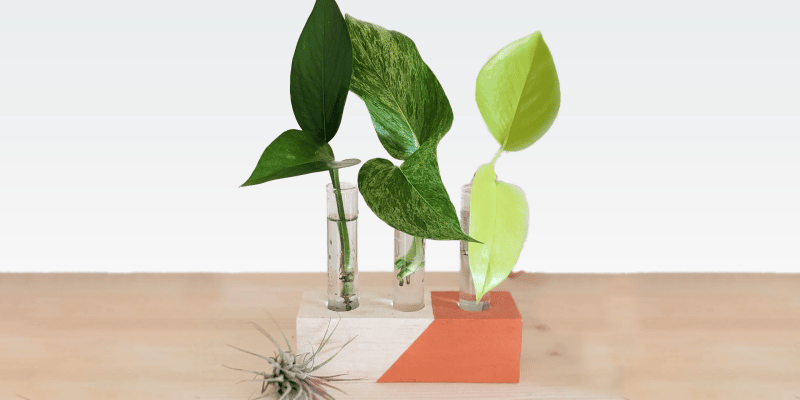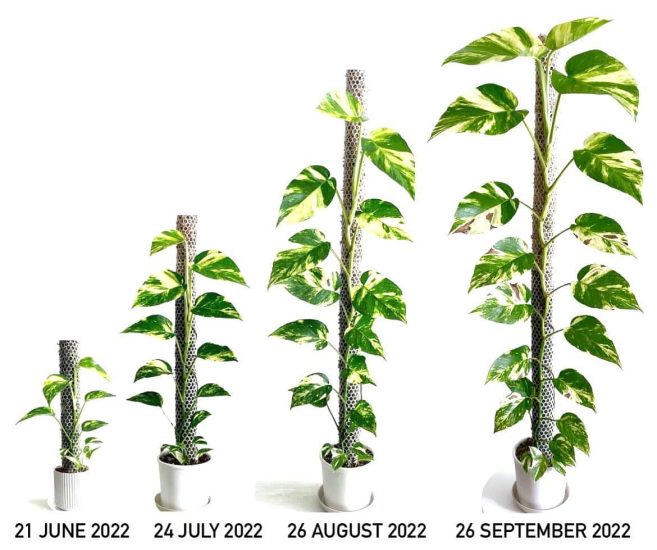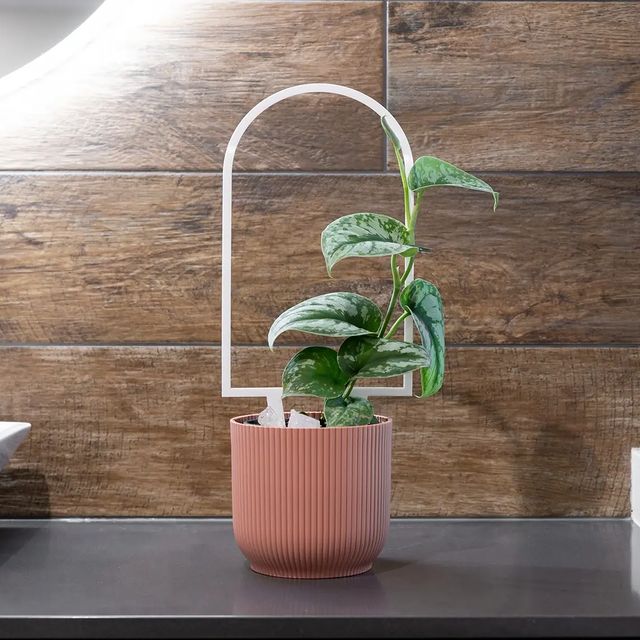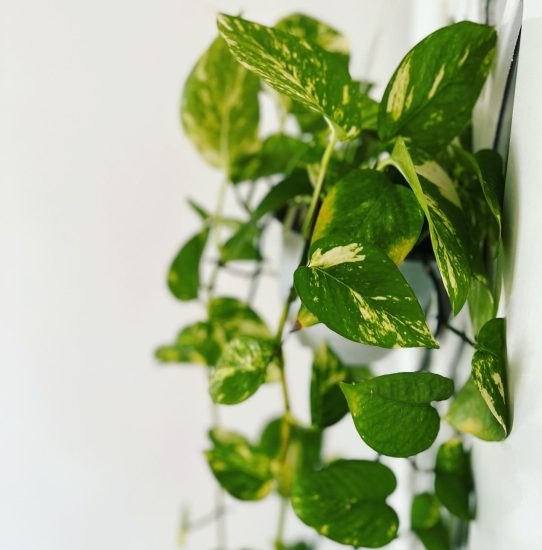Pothos plants (Epipremnum aureum) are probably the perfect houseplant.
There, I said it.
They’re actually that easy to take care of. Direct sunlight? No problem. Need your air filtered? Pothos is here for it.
They also come in so many varieties (some of them false pothos). We’ll cover the care requirements of the most popular forms, including the Golden pothos.
This is our complete Pothos care guide. We’ve worked in our recommendations on what to look out for when purchasing your plant, Pothos varieties and their unique challenges, an essential pruning trick, and a guide on propagation.
Table of Contents
Pothos Care Guide
History, habitat, and characteristics
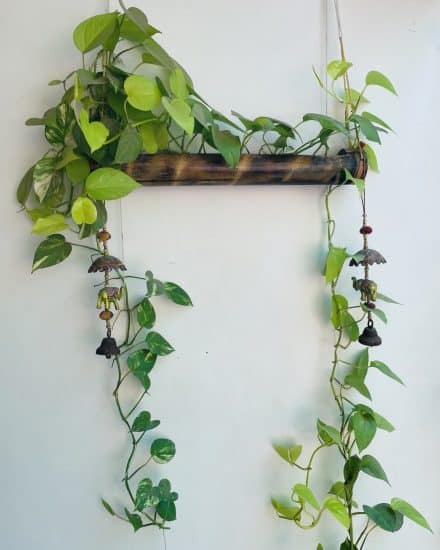
Before we get too much into the history of Pothos plants, let me just say something to encourage you if you’ve had trouble keeping indoor plants before: this plant is an exceptionally easy indoor plant to care for. Not to mention, it’s absolutely beautiful.
Pothos plants are known by many names: Devil’s Ivy, Golden Pothos, even Hunter’s Rove. When we refer to Pothos, we’re almost always referring to Golden pothos, or Epipremnum aureum. The ‘aurem’ is the golden variety.
But no matter their name, they’re all believed to originally come from volcanic islands in French Polynesia. They rarely bloom as a houseplant. Pothos vines need to reach 20+ feet long for flowers to appear.
The leaves form blunt, rounded tips, with leaf stems sporting a distinctive “knee” and adhesive aerial roots, nodes, and internodes. Growth can occur anywhere from low light, partial sun to full shade.
Vining plants like Pothos are fantastic plants to fit into any space. You can really lead them along and make space wherever you have it. Moss poles, hanging planters — they all work great, and you’ll appreciate their quick growth. For example:
Buying your first Pothos
When picking out a Pothos, consider where you’re thinking of placing it. If you want flexibility, a Golden pothos is great because it can fit in just about anywhere.
Other Pothos varieties can be a bit pickier. Pothos with heavily variegated leaves really struggle if they aren’t in bright indirect light. They can often survive just fine, but their leaves will turn completely green.
Those leaves flush with chlorophyll only have a limited amount of surface area. So those beautiful white markings on the Manjula? They can’t photosynthesize and will either need to be placed in a brighter location or they’ll soon turn green.
Golden pothos? It’s happy everywhere.
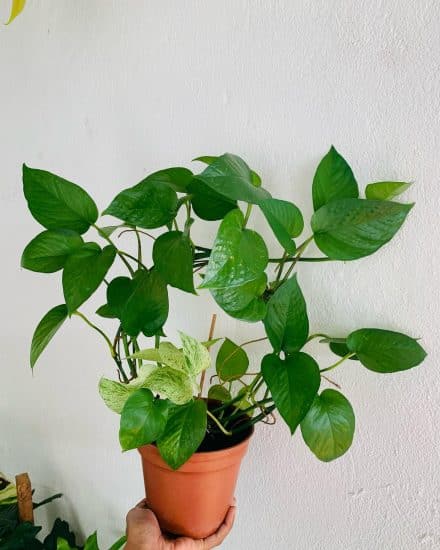
With some plants, we recommend really poking around and making sure you’re getting a quality plant with good roots. Pothos are so easy to care for that you can actually be a little less picky.
If you do want to look, loosen the soil a bit and see that out of the pot, they wrap around the soil and hold it together with an extensive root system.
Check the base of the soil and see how many “starters” (new stems) there are. A pot with more stems emerging is going to make it a lot easier to get a fuller, bushy look.
This is also a chance to really check the leaves. Are there brown/dark spots, or browning along the edges?
If so, pick a different plant with shiny, healthy leaves so that you don’t have to troubleshoot your care quite as much from the start.
Pothos varieties
We’ll cover the most popular varieties of Pothos plants here and take into account how much light you have to make sure you can support the heavily variegated varieties.
Golden pothos (Epipremnum aeurem) Most common Pothos variety. This is your workhorse pothos. Leaves should be bright yellow and green with patches of cream.
Marble Queen pothos (Epipremnum aureum ‘Marble Queen’)
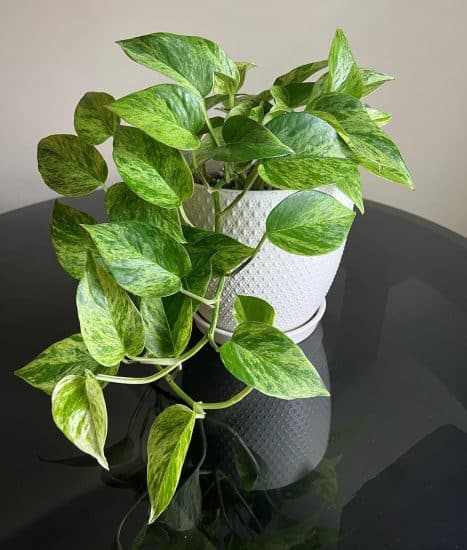
(Our complete Marble Queen pothos guide)
A fast-growing epiphyte with marbled, heart-shaped leaves ranging from green and yellow to silvery cream. Cold-hardy and able to do pretty well for a variegated plant, even in lower light.
Manjula pothos (Epipremnum aureum ‘Manjula’)
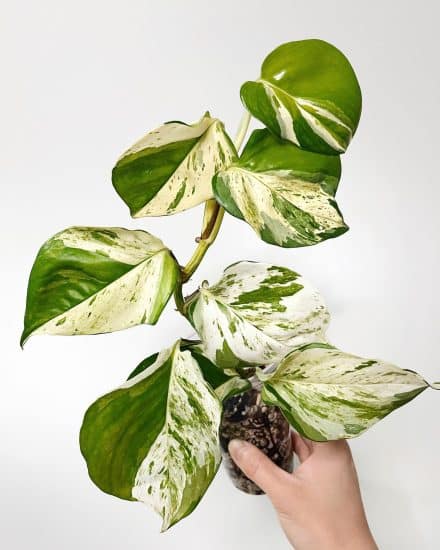
(Our full Manjula pothos care guide)
A combination of the Neon and Marble Queen pothos, their leaf tips are slightly twisted. Propagated through stem cutting clones from a lab-manufactured variety created by Ashish Hansoti. Loves lots of indirect light, but delicate within direct sun.
Cebu blue pothos (Epipremnum pinnatum ‘Cebu Blue’)
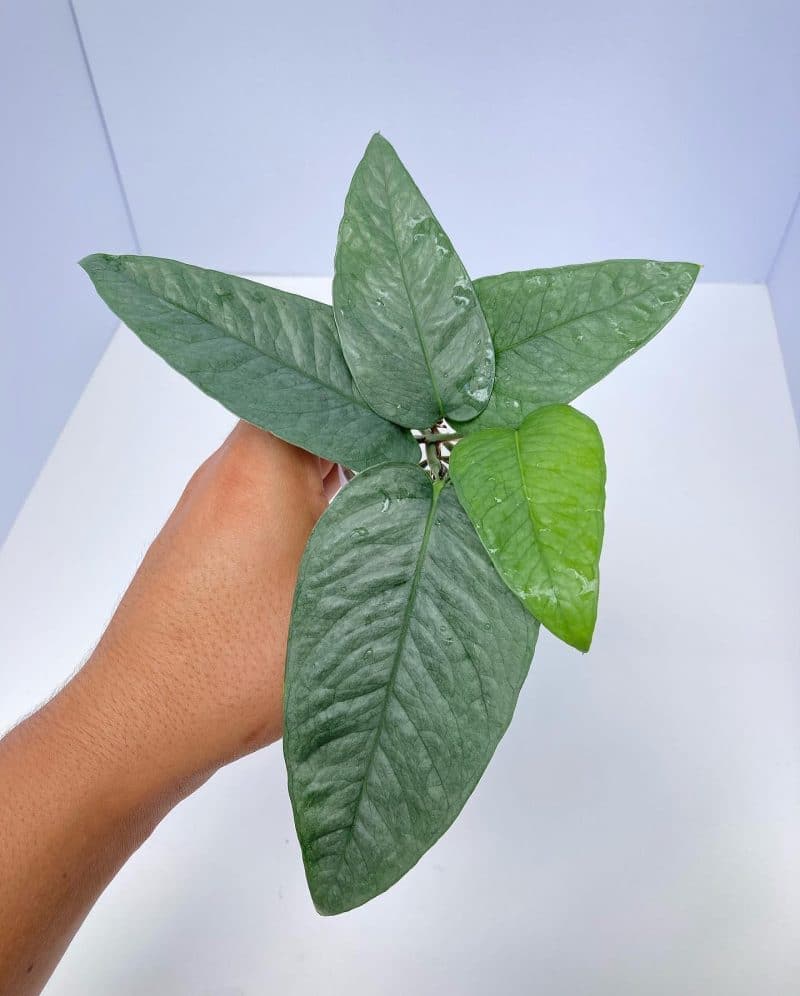
(Our full Cebu Blue pothos guide)
Named after Cebu Island, this variety appears almost blue due to the delayed production of chlorophyll and a unique physical structure in its leaves. This makes it incredibly UV resilient as a young plant and actually makes it harder for hungry insects to find it. Silver-to-blue-green leaves.
Satin Silver Pothos
(Our full Satin Pothos care guide here)
Satin pothos features beautiful elongated green leaves with delicate silver etchings. A great air purifier, they require very precise lighting conditions, as their leaves easily brown or turn completely green.
Neon pothos (Epipremnum aureum ‘Neon’)
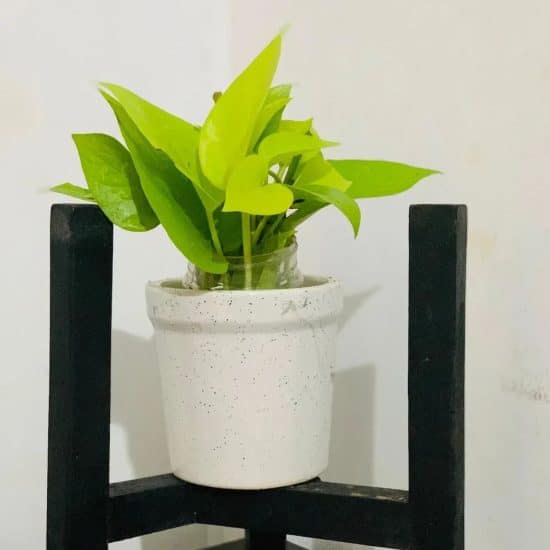
Really comes in a neon green/chartreuse (science is magic). (Our full Neon pothos guide here).
Global Green pothos (Epipremnum aureum ‘Global Green‘) – A recently patented cultivar from Japan, designed with a compact form and beautiful green marbling. (Our full Global Green pothos guide.)
Jade pothos (Epipremnun aurem ‘Jade’) – Smaller, heart-shaped leaves that are a lovely solid green. Keep out of direct sun.
Hawaiian pothos (Epipremnum aureum ‘Hawaiian’) – A climbing pothos with light-yellow/light-green variegation. Check out our Hawaiian pothos care guide to learn more about this lovely plant.
N Joy pothos (Epipremnum aureum ‘N Joy’) – A natural branch mutation of Marble Queen pothos, also known as NJoy Pothos or N’Joy Pothos. Has marbled green and white variegation, and is a bit smaller than Marble Queen, but still vines. Check out our full N Joy pothos care guide to learn more.
Light
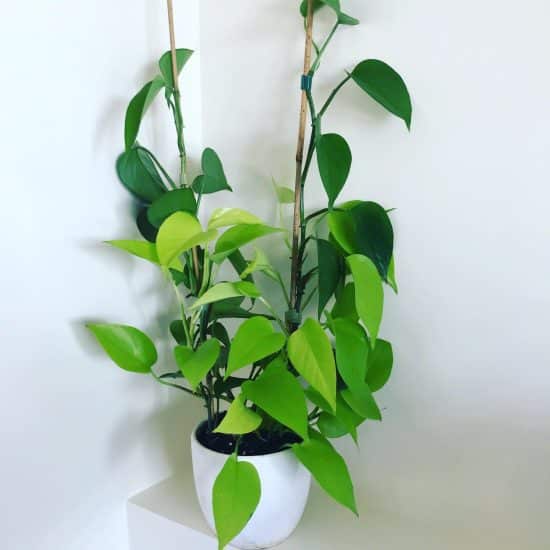
Golden pothos will be pretty happy in just about any light you give it, but it gives its best performance under bright, indirect light.
The best spot to place a Pothos is going to depend first on the variety you have. Golden pothos can really be placed anywhere, even in direct sunlight (it won’t thrive, but can survive; it just turns a bit yellowish).
(If you don’t know which Pothos you have, pay attention to the amount of variegation and read the below section.)
Golden pothos can also be placed in the middle of the room, just make sure to match any reduced light with less water. You’ll notice new heart-shaped leaves are a bit smaller, but the plant will do just fine.
If you place it somewhere too dark, you’ll lose some of its natural variegation as it turns greener. Brighter spots? It’ll get lighter and restore that variegation pretty quickly.
So experiment with placement and let the leaves tell you if you’ve nailed it.
The more variegated varieties (looking at you, Neon Pothos and Marble Queen) are a lot pickier, unless you want those beautiful, unique leaves turning dark green. Try to keep them in bright light whenever possible, avoiding the direct sun.
For a southern window placement (all direct light), you’ll really need to make sure you aren’t seeing brown spots (they’ll look burnt, crispy) on the leaves.
Water
Pothos plants love water, and they love a lot of water — but they want it all at once and then to dry out and be forgotten for a little bit. It’s essential that you do not let these plants stand in water or you’ll see brown soft spots start appearing and the leaves looking pretty sad.
It’s impossible to say how often a Pothos should be watered because every input (plant/pot size, age of plant, pot drainage, soil type, temperature and humidity level, even lighting) influences how much water they want. However, we can judge if it’s too dry: you’ll see drooping, sad-looking leaves with brown edges.
Watering too much will damage the roots and yellow the leaves. The key is to catch the oldest leaves, the ones closest to the soil, because it’ll appear here first.
One last tip: you don’t need to mist this plant, but you can wipe down its leaves with water to remove dust every few weeks. This keeps the stomata healthy and able to exchange oxygen/carbon dioxide effectively.
Your plant will thank you (but hopefully not vocally, more like… by how healthy it looks).
Tips:
- Poke your finger an inch deep in the soil every week to check for dryness.
- Water until water is pouring out of the drainage holes (you do have drainage holes, right?).
- Use lukewarm water to prevent shocking the roots.
- Water more frequently during the growing season and let the soil dry out between waterings.
- Monitor for signs of overwatering and underwatering (yellowing leaves, root rot, mold).
One last thing: you might notice water on the tips of leaves. This is nothing to worry about. Pothos have a massive root system which can suck up too much water, so to regulate, they push it out through the plant until it reaches the leaves.
No action is needed, but if you notice this, now you know why!
Temperature and humidity
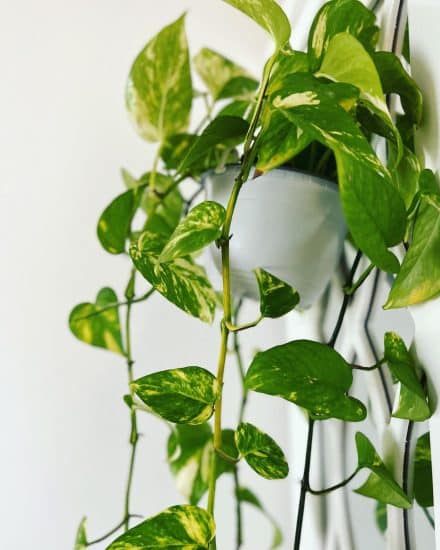
When we say Epipremnum aureum plants are easy to take care of, temperature and humidity requirements are just what we’re talking about, but there are a few exceptions.
Temperature: Pothos plants prefer normal household temperatures and can thrive just about anywhere in the home. The key is to not let it get too cold (under 60 degrees F) during transportation. Many nurseries can wrap your plant with plastic or paper, or you can even bring a favorite blanket to keep it snug if you’re buying it in the winter. If it’s summer or warm out, your plant will be fine.
Humidity: doesn’t matter quite as much with Pothos as other indoor plants. However, increased humidity will help this plant grow faster with larger leaves. The appearance and variegation won’t change all that much with humidity, though.
We do recommend not placing directly above a radiator, as excessively hot, dry air can harm Golden pothos leaves. But unlike other plants, it’ll still survive… just a bit droopier. Similarly, drafts don’t matter too much if they’re short-term.
Summary:
- Aim for 65-85 degrees F throughout the year.
- Humidity levels above 35% are great.
- Really protect this plant from temperatures below 55 degrees F.
- Avoid misting your pothos, since it doesn’t do much to raise humidity and will attract pests.
Soil and planting
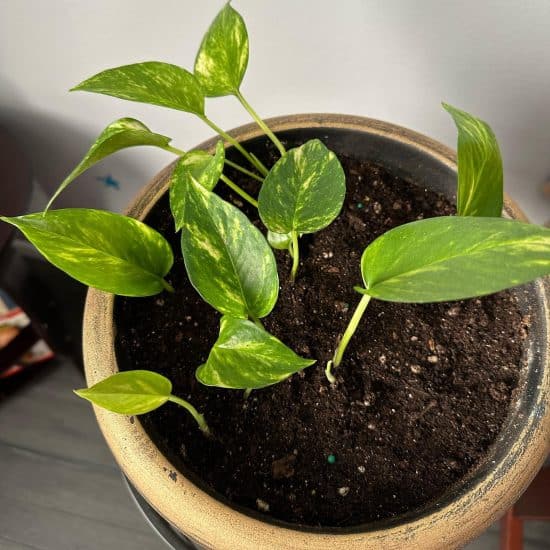
When you get your Pothos plant home the first thing to do is… actually, probably nothing. Unlike other indoor plants (we’ll use this phrase a lot), the Golden pothos (and other varieties) prefer to be a bit root bound. They like a compact root system to effectively drink water from their soil.
If you tug at your plant and find that it really seems snug in the pot, with roots growing out of the holes in the bottom, this is a good sign to repot in one or two sizes larger. Another sign it might be looking for a larger space to explore is if you see leaves that look otherwise healthy suddenly dropping off without warning .
Golden pothos is extremely tolerant of soil quality, so you can really just buy any soil that has decent drainage from a garden shop. Look for ones with perlite or pumice already mixed in, or add your own if it seems a bit dense.
For a pot, you’ll want to make sure it has drainage in the bottom, because like we mentioned above, Pothos do not like to stand in water. This can quickly cause root rot.
Fertilizer? Not really needed. You can use it twice during the growing season if desired, just make sure to dilute to 50% strength and water right after.
Pruning pothos plants
If you notice your plant getting a bit long (and if it’s in a hanging basket, this can happen pretty quickly) you might feel like it’s starting to take over your home. This is fine! The home belongs to your Pothos now, just let its vines explore as they will.
Or, if you want to reclaim a bit, you’ll want to deal with these long, leggy leaves. So how can we make it fuller?
We cut in between two nodes, cutting the long vine off and leaving a short growth. Cut just a little bit past a leaf. You’ll notice it growing not just from the node exposed at the end but also all of the undeveloped, dormant nodes along the stem.
What causes this?
That’s tricky, and it’s due to a pretty complicated and influential plant hormone known as auxin.
Auxin is responsible for many things, including how long your plant stems want to grow.
It works by being sent out to all of the nodes on your plant and suppresses new growth from any not located in the extremities of a stem. When you remove the tip, you’re changing the length of that stem and how auxin is regulated through the plant, now active in those previously napping nodes.
It makes sense that it works this way, right?
In nature, Epipremnum aureum wants new growth to explore as far as it can, capturing as much bright light as possible before going back and developing its previous nodes. In our home? We can train it a bit differently, and the plant will be just as happy with a much fuller look.
What to do with those cuttings? We’ll cover that now in our propagation section.
Propagation guide
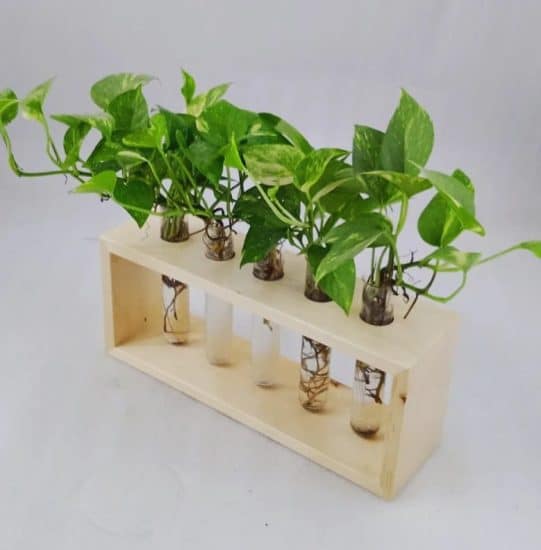
Propagating a pothos plant is about as simple as it gets. We’re going to utilize a technique called stem cuttings. These cuttings can be placed in water, moss, soil, and even LECA, and there’s a good argument in favor of each.
We’re going to cover water propagation because it’s very reliable and lets us get a glimpse of the beautiful root structure of these plants.
Propagating Pothos in water via stem cuttings
First, you’ll want to gather some glasses (not the kind you see with, but those could help), scissors, and filtered/bottled water. Rainwater works great, too.
- Using your scissors, cut off a stem from your plant at least 4-5 inches long. This stem should have at least 3 leaves, and they should look pretty healthy.
- Remove any leaves from the bottom few inches of the plant, leaving at least two still on.
- Place the cutting in water, changing it every few days in a sunny spot that doesn’t get too much direct light. High humidity is great — some people like to cover their cutting with a clear plastic bag or a soda bottle cut in half, but I haven’t found that necessary.
- In a few weeks, you’ll notice your first roots now reaching a few inches long. This means it’s time to upgrade your cutting’s habitat into its own small pot with the mix we suggested in the soil section above.
Make sure that any leaves aren’t buried in the soil, because this can promote pests and root rot. Water thoroughly and try to keep the humidity up for the first month or so.
Pothos plant propagation tips:
- Three to five leaves on a stem cutting are ideal. We don’t want much more than this because the plant will expend too much energy preserving its existing growth. No leaves? Well, that would mean no light, and that’s not great either.
- Keep the soil moist for the first few days, but after that, make sure it drains easily and water on a regular schedule. Really avoid fertilizer at this stage.
- You should always propagate during the growing season, either right at the start of spring or fall.
That’s it!
Golden pothos plants (in fact, any of the Epipremnum aureum varieties) are really easy to propagate, and I love looking at the plant as new roots emerge.
Common issues
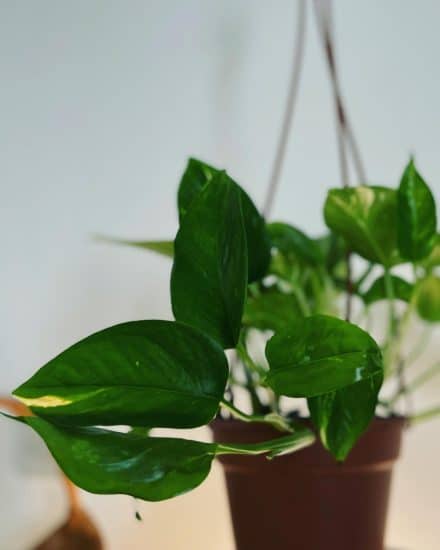
The Golden pothos plant is incredibly easy to take care of, but it can still experience small issues. The difference with this plant is most can be fixed pretty easily, and even when they can’t be… it still tends to do okay for itself.
If you suspect issues because of a change in color, leaves dropping off, or maybe a recent move, we can go through the most common issues pothos plants see one by one and their causes.
Yellow leaves
If the older leaves turn yellow or brown, but new leaves look healthy, it’s a sign that the plant is under-watered. Cut back the affected leaves and give your pothos plant a much-needed drink of water.
Pothos leaves, especially when variagated, tend to show issues very quickly. So likely, you’re going to be able to catch the root cause very quickly. If you are underwatering your plant because the soil always seems moist, I really recommend repotting with a different potting mix and making sure you have at least one drainage hole at the bottom of your pot. You can also try a terracotta pot to wick out more moisture.
When you change the growing medium, make sure to add material like perlite. We want the soil to dry (the top few inches) before watering. A fast-draining soil is going to let us water more frequently and avoid these yellow pothos leaves.
Leaves dropping off
If the leaves look otherwise healthy and are suddenly dropping off, this is almost always a sign of root issues. Most likely, you need to repot, no matter what the issue is, so gently pry the pot off and take a look. If you’re having trouble even getting the pot off or roots are coming out through the drainage holes, you likely need to repot into a larger pot one or two sizes larger. After this, you should see your plant spring right back.
Leaves with brown tips
Caused by either too much sunlight or excessive use of slow-release fertilizer. You’ll want to judge first how many leaves it’s affecting, and whether it’s just the younger, higher leaves.
This can be an indication of poor water quality. But Golden pothos aren’t too picky with water, so you’ll want to first make sure you’re not overfertilizing.
If you have a variegated Pothos and you see brown tips without its leaves turning completely green, this means it’s either in direct sunlight (there should also be white, burnt patches) or there’s a bug problem. We’ll cover bugs in the next section!
Diseases and pests
Epipremnum aurem doesn’t attract more pests than normal, but it may take you longer to spot them, and this is not because it’s a tropical vine or that it thrives so well in low light you can’t see them.
Okay, so why?
It’s just one of the easiest houseplants to care for, and Pothos thrives in so many different conditions. While other plants might show you signs or issues early, Pothos plants tend to just… hide these problems from their plant owners.
90% of the time, this is great! I mean, if the plant can tolerate low light and look happy, what’s the trouble?
Pests.
Pests
By the time you notice pests, it’s often pretty serious, and they might be affecting other plants too.
Devil’s ivy tends to attract mealybugs. They’ll look like little cotton balls. The fix isn’t too hard if you’re able to catch them early. Pick them off/spray them with some water, then use either a dish soap mixture or neem oil to treat the leaves (both sides). Always better to catch them early, so keep an eye on those leaves and stems.
Root rot
Root rot is an unfortunately common issue for all indoor plants, including Epipremnum aureum.
You used fresh potting soil, you gave your Pothos vines plenty of bright, indirect light… so what happened?
If you let the plant stand in water or don’t wait for dry soil before watering again, these are your problems. The fix is to replant in soil that won’t just stay wet — that is, soil that has plenty of perlite, pumice, or LECA added to add aeration and drainage.
When you’re replanting, examine the plant’s roots for any that are mushy, slimy, and brown or black. You’ll want to cut those off, sterilizing the scissors before and after in boiling water or alcohol.
Conclusion
Pothos plants are some of the easiest houseplants to care for. As naturally vining plants (epiphytes), they love structures like tree trunks, moss poles — really whatever you give their aerial roots a chance to grip — which makes them perfect for a hanging basket too.
Pothos prefers brighter light than many other plants you might keep, so don’t be surprised if they become a bit leggy as they reach out for it.
Care tips:
- Avoid excess water accumulation in their pots/baskets, but provide drainage holes and an aerated soil.
- Check for roots that start coming out of those holes. This is a good sign it’s time to repot.
- Watering should be thorough and whenever you feel the soil has dried up. Drooping vines can be a sign that you’re not watering this plant enough, so pick up that pace!
Pothos come in so many incredible varieties, and we’d love to see yours! Feel free to drop us a line with pictures, questions, or if there’s anything you think we should add to this guide.
Take care!
FAQ
What is a Pothos plant?
Pothos (Epipremnum aureum) is a tropical vine with heart shaped green leaves that comes from Mo’oera in French Polynesia. It’s also called Devil’s ivy, hunter’s robe, or Golden pothos.
Does Golden pothos need direct sunlight or indirect light?
The light conditions for your Pothos plant will depend a lot on whether or not it’s variegated. A Golden pothos tends to do well in less light, whereas a Neon Pothos prefers bright, indirect light and lots of it.
How much sunlight does it need? You’ll know it’s getting enough light because it’ll retain its unique variegation and not show signs of turning completely green.
Another thing to look for are its internodes, the distance from one node to the next. You’ll notice, especially in hanging form, that these will get longer if the plant is in a darker location. So if you want a fuller look, you’ll need to keep the light levels high: Pothos vines really prefer bright indirect light.
Should I mist my pothos?
We generally recommend against misting most indoor plants. It’s much better to use a damp cloth to wipe down any leaves, since this will help clear dust from the stomata and improve their light-gathering abilities.
What is the best potting soil for Pothos plants?
This is only a partial joke, but: anything that resembles soil. Honestly, a Pothos plant does well in almost anything you can buy at a garden center if it’s in a pot with drainage holes.
Hanging baskets work great too. I tend to prefer a faster draining soil for these so they can be hung up more quickly after watering.

